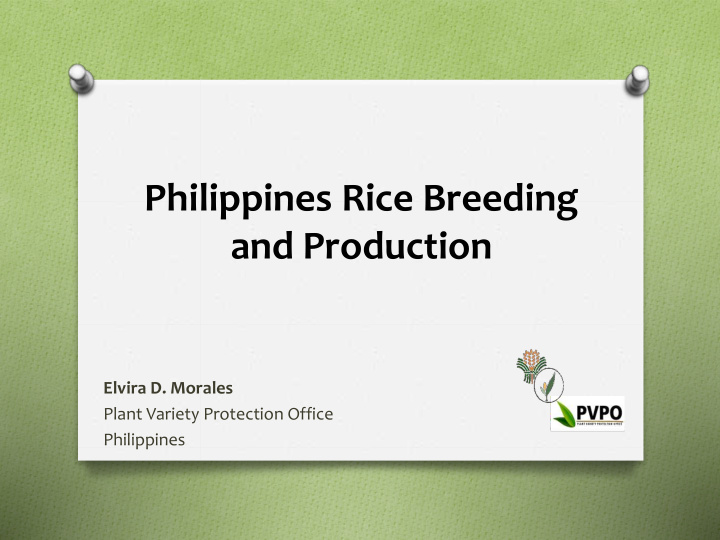



Philippines Rice Breeding and Production Elvira D. Morales Plant Variety Protection Office Philippines
O GOAL Increase productivity in the different rice growing ecosystems O OBJECTIVE To identify high yielding rice lines with tolerance to biotic and abiotic stresses and good grain quality that can adapt to the different rice growing ecosystems
Plant Breeding Priorities O Increasing yield potential O Multiple resistance to diseases and insects O Increasing tolerance for abiotic Stresses O Superior quality O Appropriate growth duration O Efficient nutrient uptake and utilization O Adaptation to climate change
Breeding Centers Breeding Centers IRRI UPLB PhilRice Other private companies
Roll of breeding centers Role of Breeding Centers Generate promising lines and submit to national programs for test in specific regions/sites a line performing better than commercially cultivated varieties = recommended for release as new variety The agency sponsoring the line for release provides the breeder seed for foundation seed production.
BREEDING PROGRAMS Breeding Programs O DEVELOPMENT OF IRRIGATED LOWLAND RICE • Transplanted Inbred Rice • Direct seeded Inbred Rice O DEVELOPMENT OF HYBRID RICE O DEVELOPMENT OF SPECIAL PURPOSE RICE O Variety development for rainfed, upland and abiotic stress-prone environments
Strategies and breeding methods
Conventional hybridization and selection procedures • Basic, time-tested • To generate and utilize existing genetic variation • Generates a wide array of combinations of the genes coming from the parent plants • Cross-pollination followed by several cycles of selection and self- pollination stable promising lines candidate varieties
Cutting-edge Technology Development in support to breeding • Biotechnology • increasing breeding efficiency • improving resistance/tolerance to biotic & abiotic stresses • Molecular marker technology • using marker-aided selection • germplasm characterizations • Induced mutations • In vitro techniques- developing lines for adverse environments • Physical & Chemical mutagenesis • Genetic engineering • cloning/introduction of important genes • Wide hybridization • transferring resistance genes
Process of Varietal Release at the NCT UPLB PhilRice IRRI PRIVATE Multi-location Tests (NCT) • Yield Trial • Insect Screening • Disease Screening • Grain Quality Evaluation Rice Technical Evaluates results of NCT, drop Working Group and accept new entries Recommends Technical promising entries Secretariat National Seed Approve release of new varieties Industry Council
Varietal Development and Release Breeding objectives Hybridization of Segregating selected parents Performance Trial population Year 1 Year 2-3 Year 4-6 NCT Phase I (on-station) Year 7-8.5 Seed Increase (Breeding Institution) NSIC MAT (on-farm) Year 9 Basic Seed Production (PBBD) New variety for release Year 9.5-11 Farmers Breeder/Foundation SP(IGO) Grain millers & retailers Foundation/Registered Year 12 SP(IGO/Seed Net/Seed Growers) Consumers Certified Seeds
The testing sites ... Testing Sites….. The Philippine The Philippine Rice R&D Rice R&D Network Network Composition (57) Composition (57) 2 national centers 6 branch stations 12 regional research stations 37 cooperating stations
Number of Recommended Varieties by Ecosystem from 1968 to 2013 Period Irrigated Rainfed Upland Cool Saline TOTAL lowland lowland elevated 1968-1988 43 4 7 - - 54 1990-2010 87 17 6 6 13 129 • - 2011-2013 57 11 1 13 82 TOTAL 187 32 14 6 26 265
Trends in Philippine Rice Production
Classes of Seeds Classes of Seed comes directly from plant breeder Breeder Seed Foundation Seed grown from breeder seed Registered Seed grown from foundation seed grown from either foundation, Certified Seed registered or certified seed grown from certified and maybe used Good Quality in times of emergencies Seed Seed that are of seed increase status as determined by the RTWG
Paddy yield, 2000-2011 Irrigated Non-irrigated All Ecosystems mt/ha 4.5 4.0 3.5 3.80 3.68 3.0 3.07 2.5 2.0 2000 2002 2004 2006 2008 2010 Yield peaked in 2007 at 3.80 mt/ha. Highest yield was 4.21 mt/ha in irrigated areas; 2.98 mt/ha in non-irrigated areas.
GROWTH IN YIELD Growth (in mt/year) 2000-2010 2010-2011 All Ecosystems 63 55 Irrigated 58 36 Non-Irrigated 66 146 Growth (in %) 2000-2010 2010-2011 All Ecosystems 1.83 1.54 Irrigated 1.53 0.90 Non-Irrigated 2.53 5.36
HARVEST AREA, 2000-2011 Irrigated Non-irrigated M ha ha 5.0 4.54 4.5 4.04 4.0 3.5 3.0 2.5 2.0 1.5 1.0 0.5 0.0 2000 2002 2004 2006 2008 2010 Harvest area grew by 12% in the last 12 years. Irrigated areas comprised 68%.
GROWTH IN HARVEST AREA Growth (in mt/year) 2000-2010 2010-2011 All Ecosystems 47,773 182,481 Irrigated 38,655 64,312 Non-Irrigated 9,118 118,169 Growth (in %) 2000-2010 2010-2011 All Ecosystems 1.13 4.24 Irrigated 1.35 2.15 Non-Irrigated 0.66 9.07
Paddy Production, 2000-2011 Irrigated Non-irrigated M mt mt 18.0 16.82 16.68 16.0 14.0 12.39 12.0 10.0 8.0 6.0 4.0 2.0 0.0 2000 2002 2004 2006 2008 2010 Production grew by 35% in the last 12 years. Irrigated areas contributed 74%.
GROWTH IN PRODUCTION Growth (in mt/year) 2000-2010 2010-2011 All Ecosystems 428,236 911,743 Irrigated 314,394 366,472 Non-Irrigated 113,842 545,271 Growth (in %) 2000-2010 2010-2011 All Ecosystems 2.96 5.78 Irrigated 2.88 3.06 Non-Irrigated 3.19 14.43
Recommend
More recommend